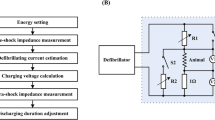Abstract
An analytical approach to the problems of waveform optimisation for cardiac defibrillation is presented. A theoretical analysis based upon an assumed equivalent circuit with constant parameters has shown that (a) thermal dissipation within the resistive tissue in series with the cardiac component of the load is minimised if the charge through it is made to flow at a constant rate, and (b) in all but extreme situations the thermal dissipation in the cardiac circuit as a whole is minimised when a constant current pulse is used to defibrillate.
Similar content being viewed by others
References
Crampton, R. (1980) Accepted, controversial, and speculative aspects of ventricular defibrillation.Progress in Cardiovascular Diseases,23, 167–186.
Geddes, L. A. (1976) Electrical ventricular defibrillation. InIEE Medical Electronics Monographs 18–22,Hill, D. W. andWatson, B. W. (Eds.) Peter Peregrinus 42–72.
Tacker, W. A. andGeddes, L. A. (1980)Electrical defibrillation. CRC Press Inc.
Author information
Authors and Affiliations
Rights and permissions
About this article
Cite this article
Hoffmann de Visme, G., Furness, A. Electrical waveforms for cardiac defibrillation which dissipate least heat in the cardiac circuit. Med. Biol. Eng. Comput. 21, 259–263 (1983). https://doi.org/10.1007/BF02478491
Received:
Accepted:
Issue Date:
DOI: https://doi.org/10.1007/BF02478491




